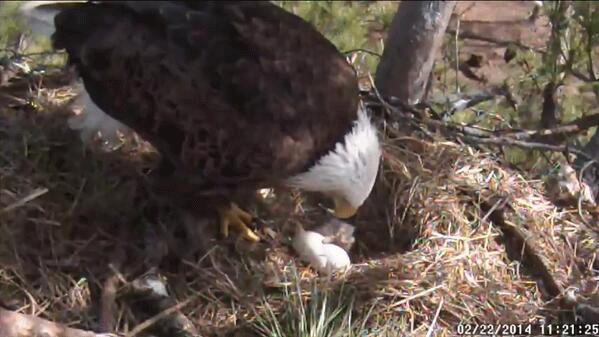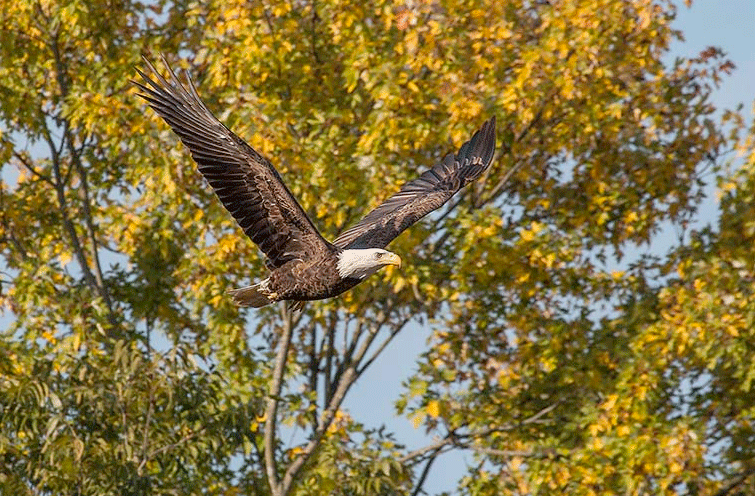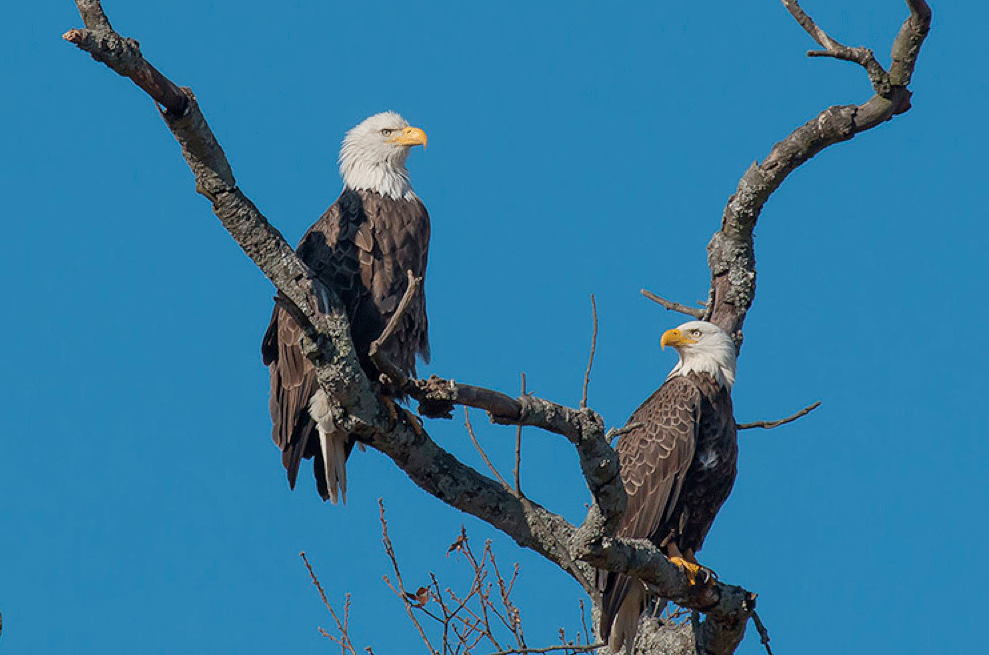Bald Eagle Hatchling on Webcam
Air Date: Week of February 28, 2014

The newly hatched eaglet. (Photo courtesy of Berry College)
A camera on Berry College’s campus in Mt. Berry, Georgia provides a real-time view of a hatched bald eagle and its parents. Biologist Dr. Renee Carleton tells host Steve Curwood about the eaglet.
Transcript
CURWOOD: It's Living on Earth, I'm Steve Curwood. A few weeks ago we spoke with Berry College biologist Renee Carlton, about the school’s Eagle cam that broadcasts a live feed of a pair of bald eagles nesting on campus. And we heard there has been a development. So we thought we'd call up Professor Carleton.
[PHONE RINGING]
CARLETON: [ANSWERS] Renee Carleton.
CURWOOD: Hi, Renee Carleton. Steve Curwood here at Living on Earth. How you are?
CARLETON: Hi, Steve. I’m great.
CURWOOD: I understand you have news for us about the bald eagles?
CARLETON: We do. On Saturday, an eaglet hatched, and the mother and father have been feeding it. I was just looking at the nest cam a few minutes ago and the little one had a nice big meal, and now mother’s tucked it away and it’s taking a nap.
CURWOOD: I see. I’m looking at the camera now, and I just see mom there and some stuff off to the side.
CARLETON: Let’s say that’s the fridge?
CURWOOD: OK. [LAUGHS]

The female eagle out hunting. (Photo courtesy of Berry College Eagle Cam Photo Gallery)
CARLETON: There’s a couple of fish heads, and also there’s remains of a coot, which is a type of waterfowl that is very common prey item for eagles, so plenty of food there.
CURWOOD: Um, sounds yummy.
CARLETON: Yeah.
CURWOOD: Now, how soon will we see the chick?
CARLETON: Well, every time it gets hungry it starts to move around a little bit, so probably in every half hour or so you can actually get a peek. It’s all covered with a gray down, really cute, and just looks around. It’s getting much more alert now, moving around a little bit more and getting more coordinated so it’s growing a little bit every day.
CURWOOD: How soon will it fly?
CARLETON: Well, they’re usually in the nest for quite a long period of time. The last pair of eaglets that were produced last year were born or hatched in late January, and they left the nest in late April. So that’s a span for about four months. The young eaglet will be the same size as its parents when it begins its flight. So we’ve got a little ways to wait...
CURWOOD: Wait a second. You’re saying this eaglet has to be the same size as mom and dad before it can fly?
CARLETON: That’s correct.
CURWOOD: Wow, they have a lot of feeding to do.
CARLETON: They do, and the pair will be busy making sure that there’s plenty of food available. They’ll work really hard to ensure that this eaglet makes it.
CURWOOD: I’m looking here at your website, that’s Berry.edu/eaglecam hoping that we’ll see this young one come out. Mom has turned her head around now. She’s tucked her head under her wing. It looks like she’s going to sleep?
CARLETON: It looks like she’s going to take a nap.
CURWOOD: Well, I guess it’s hard work raising young eagles.

Both eagles perched on a tree. (Photo courtesy of Berry College Eagle Cam Photo Gallery)
CARLETON: It is, you know. It’s kind of a good napping day anyway with the sun behind the clouds. It’s a bit breezy and cool, so she’s settled down for a little bit of a nap. Well deserved.
CURWOOD: Alright, we’ll check back with you later when the young one gets a lot bigger.
CARLETON: OK.
CURWOOD: Renee Carlton is a biologist at Berry College in Mt. Berry, Georgia. Thanks so much, Renee.
CARLETON: You’re welcome.
Links
Living on Earth wants to hear from you!
Living on Earth
62 Calef Highway, Suite 212
Lee, NH 03861
Telephone: 617-287-4121
E-mail: comments@loe.org
Newsletter [Click here]
Donate to Living on Earth!
Living on Earth is an independent media program and relies entirely on contributions from listeners and institutions supporting public service. Please donate now to preserve an independent environmental voice.
NewsletterLiving on Earth offers a weekly delivery of the show's rundown to your mailbox. Sign up for our newsletter today!
 Sailors For The Sea: Be the change you want to sea.
Sailors For The Sea: Be the change you want to sea.
 The Grantham Foundation for the Protection of the Environment: Committed to protecting and improving the health of the global environment.
The Grantham Foundation for the Protection of the Environment: Committed to protecting and improving the health of the global environment.
 Contribute to Living on Earth and receive, as our gift to you, an archival print of one of Mark Seth Lender's extraordinary wildlife photographs. Follow the link to see Mark's current collection of photographs.
Contribute to Living on Earth and receive, as our gift to you, an archival print of one of Mark Seth Lender's extraordinary wildlife photographs. Follow the link to see Mark's current collection of photographs.
 Buy a signed copy of Mark Seth Lender's book Smeagull the Seagull & support Living on Earth
Buy a signed copy of Mark Seth Lender's book Smeagull the Seagull & support Living on Earth

